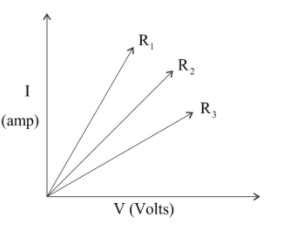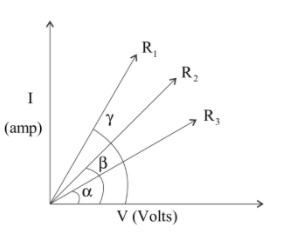
A student carries out an experiment and plots the V-I graph of three samples of nichrome wire with resistance ${R_1},{R_2},{R_3}$ respectively (see in figure). Which of the following is true?
A) ${R_1} = {R_2} = {R_3}$
B) ${R_1} = {R_2} = {R_3}$
C) ${R_1} < {R_2} < {R_3}$
D) ${R_2} > {R_3} > {R_1}$


Answer
449.5k+ views
Hint: This question can be solved by using ohm’s law and slope determining method as more the angle with the x-axis more will be the slope .As we know slope for any graph $ = \tan \theta $
Or in other words it is ratio of Y coordinate to the X coordinate
Hence, $\tan \theta = \dfrac{y}{x}$
Complete step by step answer:
According to the question given we have information from the graph as follows:
Resistance, Angle or slope for current and potential difference
As discussed above no calculative value is given so we will proceed with slope method
Always assumes of normal temperature if not given in the question because as temperature rises Ohms law will no longer be valid

According to Ohm’s Law, $V = IR$ where v is the voltage, $I$ is the current and R is the resistance
Let’s study the graph above,
Slope $ = \tan \theta = \dfrac{V}{I} = \dfrac{1}{R}$
(by ohm's law)
As $\alpha > \beta > \gamma $
So, $\tan \gamma > \tan \beta > \tan \alpha $
That means $\dfrac{1}{{{R_1}}} > \dfrac{1}{{{R_2}}} > \dfrac{1}{{{R_3}}}$
On reciprocating we get,
${R_3} > {R_2} > {R_1}$
So, the conclusion is more the angle lesser will be the resistance only for this graph
Hence option (C) is correct.
Note: Ohm's law is only valid for normal temperatures, at high temperatures it fails as wire develops lots of heat due to which resistance automatically increases and the uniformity in ohm's Law destroys. In that case resistance changes depending on the nature of material that is metal, non-metal and semiconductors.
Or in other words it is ratio of Y coordinate to the X coordinate
Hence, $\tan \theta = \dfrac{y}{x}$
Complete step by step answer:
According to the question given we have information from the graph as follows:
Resistance, Angle or slope for current and potential difference
As discussed above no calculative value is given so we will proceed with slope method
Always assumes of normal temperature if not given in the question because as temperature rises Ohms law will no longer be valid

According to Ohm’s Law, $V = IR$ where v is the voltage, $I$ is the current and R is the resistance
Let’s study the graph above,
Slope $ = \tan \theta = \dfrac{V}{I} = \dfrac{1}{R}$
(by ohm's law)
As $\alpha > \beta > \gamma $
So, $\tan \gamma > \tan \beta > \tan \alpha $
That means $\dfrac{1}{{{R_1}}} > \dfrac{1}{{{R_2}}} > \dfrac{1}{{{R_3}}}$
On reciprocating we get,
${R_3} > {R_2} > {R_1}$
So, the conclusion is more the angle lesser will be the resistance only for this graph
Hence option (C) is correct.
Note: Ohm's law is only valid for normal temperatures, at high temperatures it fails as wire develops lots of heat due to which resistance automatically increases and the uniformity in ohm's Law destroys. In that case resistance changes depending on the nature of material that is metal, non-metal and semiconductors.
Recently Updated Pages
Wheatstone Bridge - Working Principle, Formula, Derivation, Application

Young's Double Slit Experiment Step by Step Derivation

JEE Atomic Structure and Chemical Bonding important Concepts and Tips

JEE Amino Acids and Peptides Important Concepts and Tips for Exam Preparation

JEE Electricity and Magnetism Important Concepts and Tips for Exam Preparation

Chemical Properties of Hydrogen - Important Concepts for JEE Exam Preparation

Trending doubts
JEE Main 2025 Session 2: Application Form (Out), Exam Dates (Released), Eligibility, & More

JEE Main 2025: Derivation of Equation of Trajectory in Physics

Electric Field Due to Uniformly Charged Ring for JEE Main 2025 - Formula and Derivation

Electric field due to uniformly charged sphere class 12 physics JEE_Main

Degree of Dissociation and Its Formula With Solved Example for JEE

Displacement-Time Graph and Velocity-Time Graph for JEE

Other Pages
JEE Advanced Marks vs Ranks 2025: Understanding Category-wise Qualifying Marks and Previous Year Cut-offs

JEE Advanced 2025: Dates, Registration, Syllabus, Eligibility Criteria and More

JEE Advanced Weightage 2025 Chapter-Wise for Physics, Maths and Chemistry

JEE Advanced 2025 Notes

Electrical Field of Charged Spherical Shell - JEE

Learn About Angle Of Deviation In Prism: JEE Main Physics 2025




